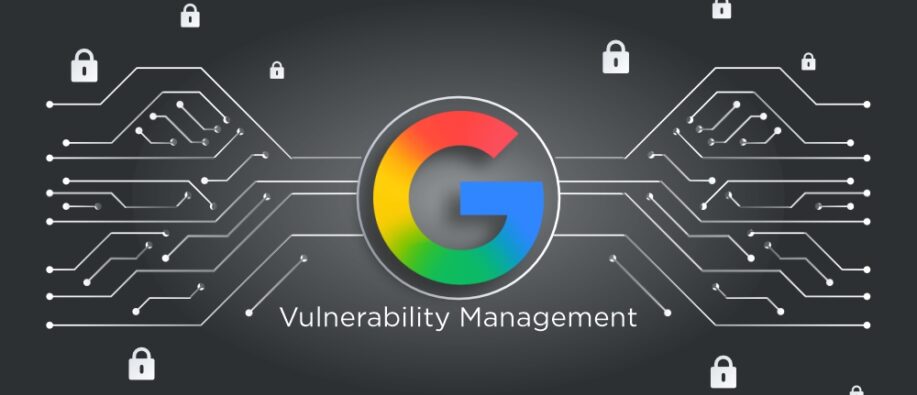Google’s vulnerability management system highlights, emphasizes, and remedies security risks. This is a proactive and AI-driven approach, that allows Google to nullify the threats before they exploit the vulnerabilities.
Google being a big tech company, its vulnerability management system acts on a very high-tech cybersecurity framework and has an ecosystem consisting of clouds, services, applications, and software that they continuously oversee and protect them to in turn protect their users.
To make a big system successful, there are some key pillars that this system relies on. Let’s check them out!
Understanding Google’s Vulnerability Management System
Google’s Vulnerability Management System refers to a strategic approach to identify, evaluate, and address security weaknesses withing Google’s services, tools, and infrastructure.
Google’s vulnerability management system is a procedure with three important steps.
In simple terms, a start always begins with identifying the issue. The first step here is identification of vulnerabilities as well, followed by the prioritization of the vulnerabilities considering the impact they can have, which in next step dealt swiftly with by the implementation of the revitalization strategies. Patch work for the issues isn’t the aim here, but to anticipate and deal with them in an orderly fashion.
Reliable Pillars of Google’s Vulnerability Management System
1. Detection of the Cybersecurity Vulnerabilities
Google’s vulnerability management system is initiated by discovering flaws that can pose threats and compromise its systems. Researchers on a daily basis find hundreds and thousands of vulnerabilities but not necessarily that they relate to that of Google’s framework. To simplify the procedure, Google reckons that the partnership of automated systems and security analysts would identify the vulnerabilities that impact Google’s products and services.
Google also has a Google vulnerability program which is essentially a bug bounty drive that rewards security analysts outside Google’s infrastructure if they find any flaws within Google’s systems. This allows Googles to access a wider expertise of cybersecurity experts into its vulnerability management, tackling potential threats of various kinds.
2. Ranking Vulnerabilities According to the Priorities
After discovering the vulnerabilities through Google’s vulnerability management system, the next step is to prioritize which flaws require immediate examination. Ranking them according to prioritization isn’t an easy task; it involves testing different factors like the vulnerability, importance of the affected asset, and the likely risks to the user.
The impact assessment process decides the prioritization of vulnerabilities. This process examines the extent of the vulnerability, discovering the troubled systems, and estimates the repercussions of the attack. Vulnerabilities like ACE (Arbitrary Code Execution) are given priority over less severe issues like DoS (Denial-of Service).
Complex factors are also considered during the process of prioritization; this can affect a small percentage of the users as they may not be provided with instant attention for a flaw.
3. Implementation Of the Revitalization Strategies
This is the step of solutions or actions. Google’s products and services deal with worldwide users, so security flaws of any size can have consequential ramifications. Google uses different tools and plans to quicken the restoration process. This is done by the product engineering team which deploys security flaw solutions to solve the issues quickly and efficiently. Before rolling out the security fixes on full-scale, Google’s vulnerability management system team pushes the fixes just to a few real-world segments to validate whether the fixes work as intended.
Google focuses on reaching its users with speed and quality, so, if there is any critical vulnerability, then Google triggers distinctive procedures to quicken the amending process warranting the fix patches reaches users with speed and without affecting the quality.
Just responding to the vulnerabilities isn’t enough; Google’s vulnerability management system also includes proactive threat detection and gathering intelligence. To lower the likelihood of successful attacks, staying ahead of possible attacks is key. Using advanced analytics to detect the peculiarities within the system could indicate the possibility of an attack.
4. Cross Functional Association
The importance that Google’s vulnerability management system puts in association and communication is extraordinary. For the smooth rectification of the security shortcomings, Google has instilled a unified approach involving the product team, security maintenance and engineer team, legal team along with communication team as well.
This cross-management communication allows productive resource disbursement and ensures that the security issues are sorted promptly. It also associates with outside entities like regulators and industry associates to stay in the loop with growing threats and liabilities. Engaging with a wider spectrum of cybersecurity communities, Google achieves insights into the newest attack angles, thus finetuning its flaw detection system.
5. Automation: The Hero
Automation is another pillar that Google’s vulnerability management system relies on. Automated tools are used by Google to scan flaws in security across its infrastructure and commodities, allowing them to scan vulnerabilities quickly and with better accuracy. These automated tools can run uninterrupted scans, discovering issues instantaneously keeping Google’s system safe.
Scanning the vulnerabilities and identification has a critical role to play in supporting Google in responding quicker to forthcoming threats. Google also uses machine learning to intensify its flaws in security capabilities.
6. Anticipatory Detection of Threat and Compliances
After vulnerabilities are tackled, the process doesn’t end there, Google makes sure that they are monitored for compliance. It uses security health analytics to detect new issues continuously and also tracks the status of previously corrected issues. In clouds, security command centers are used to track compliance with standards of security.
In order to assist organizations in mitigating possible risks and ensuring adherence to industry standards like PCI DSS and SOC 2, the service automatically identifies problems and produces findings. Furthermore, the Security Command Center automatically updates the findings' status to reflect the remediation of vulnerabilities once they have been successfully mitigated. This guarantees that businesses can keep a close eye on their security posture and spot any emerging vulnerabilities.
What Can the Decision Makers Learn from Google’s Vulnerability Management System?
Decision makers looking to reinforce their organization’s security structure or performance can take a cue from Google’s vulnerability management system approach of ongoing attention to detail and flexibility. One important lesson learned is how crucial it is to incorporate AI and automated tools into the vulnerability management process so that businesses can efficiently progress. As a best practice for businesses of all sizes, putting a strong emphasis on cross-departmental collaboration guarantees that teams are in agreement regarding vulnerabilities and security measures. Decision makers establish a security ecosystem that tackles current threats and foresees and reduces potential hazards by constructing a robust, proactive framework and collaborating with both internal and external partners.
For big businesses struggling with vulnerability management systems, Google's approach sets a new benchmark as cyber threat scenarios evolve. By integrating technology, internal collaboration, and strategic external relationships, Google has created a system that foresees and addresses security threats.
Decision makers and security experts can learn a lot from this model about building strong, scalable security frameworks that are resistant to both current and new cyber threats. It serves as a proactive model for a digital world that is always changing.
For more informative blogs on cybersecurity and trends, check out SecureITWorld!
Also Read: Are Google AI Overviews Destroying Your Website Traffic Here’s the Truth






